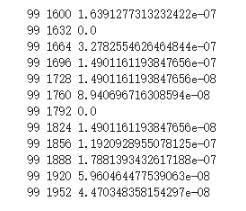最新下载
热门教程
- 1
- 2
- 3
- 4
- 5
- 6
- 7
- 8
- 9
- 10
PyTorch如何实现VGG16 PyTorch实现VGG16代码示例
时间:2020-06-24 编辑:袖梨 来源:一聚教程网
PyTorch如何实现VGG16?本篇文章小编给大家分享一下PyTorch实现VGG16代码示例,代码介绍的很详细,小编觉得挺不错的,现在分享给大家供大家参考,有需要的小伙伴们可以来看看。
代码如下:
import torch
import torch.nn as nn
import torch.nn.functional as F
class VGG16(nn.Module):
def __init__(self):
super(VGG16, self).__init__()
# 3 * 224 * 224
self.conv1_1 = nn.Conv2d(3, 64, 3) # 64 * 222 * 222
self.conv1_2 = nn.Conv2d(64, 64, 3, padding=(1, 1)) # 64 * 222* 222
self.maxpool1 = nn.MaxPool2d((2, 2), padding=(1, 1)) # pooling 64 * 112 * 112
self.conv2_1 = nn.Conv2d(64, 128, 3) # 128 * 110 * 110
self.conv2_2 = nn.Conv2d(128, 128, 3, padding=(1, 1)) # 128 * 110 * 110
self.maxpool2 = nn.MaxPool2d((2, 2), padding=(1, 1)) # pooling 128 * 56 * 56
self.conv3_1 = nn.Conv2d(128, 256, 3) # 256 * 54 * 54
self.conv3_2 = nn.Conv2d(256, 256, 3, padding=(1, 1)) # 256 * 54 * 54
self.conv3_3 = nn.Conv2d(256, 256, 3, padding=(1, 1)) # 256 * 54 * 54
self.maxpool3 = nn.MaxPool2d((2, 2), padding=(1, 1)) # pooling 256 * 28 * 28
self.conv4_1 = nn.Conv2d(256, 512, 3) # 512 * 26 * 26
self.conv4_2 = nn.Conv2d(512, 512, 3, padding=(1, 1)) # 512 * 26 * 26
self.conv4_3 = nn.Conv2d(512, 512, 3, padding=(1, 1)) # 512 * 26 * 26
self.maxpool4 = nn.MaxPool2d((2, 2), padding=(1, 1)) # pooling 512 * 14 * 14
self.conv5_1 = nn.Conv2d(512, 512, 3) # 512 * 12 * 12
self.conv5_2 = nn.Conv2d(512, 512, 3, padding=(1, 1)) # 512 * 12 * 12
self.conv5_3 = nn.Conv2d(512, 512, 3, padding=(1, 1)) # 512 * 12 * 12
self.maxpool5 = nn.MaxPool2d((2, 2), padding=(1, 1)) # pooling 512 * 7 * 7
# view
self.fc1 = nn.Linear(512 * 7 * 7, 4096)
self.fc2 = nn.Linear(4096, 4096)
self.fc3 = nn.Linear(4096, 1000)
# softmax 1 * 1 * 1000
def forward(self, x):
# x.size(0)即为batch_size
in_size = x.size(0)
out = self.conv1_1(x) # 222
out = F.relu(out)
out = self.conv1_2(out) # 222
out = F.relu(out)
out = self.maxpool1(out) # 112
out = self.conv2_1(out) # 110
out = F.relu(out)
out = self.conv2_2(out) # 110
out = F.relu(out)
out = self.maxpool2(out) # 56
out = self.conv3_1(out) # 54
out = F.relu(out)
out = self.conv3_2(out) # 54
out = F.relu(out)
out = self.conv3_3(out) # 54
out = F.relu(out)
out = self.maxpool3(out) # 28
out = self.conv4_1(out) # 26
out = F.relu(out)
out = self.conv4_2(out) # 26
out = F.relu(out)
out = self.conv4_3(out) # 26
out = F.relu(out)
out = self.maxpool4(out) # 14
out = self.conv5_1(out) # 12
out = F.relu(out)
out = self.conv5_2(out) # 12
out = F.relu(out)
out = self.conv5_3(out) # 12
out = F.relu(out)
out = self.maxpool5(out) # 7
# 展平
out = out.view(in_size, -1)
out = self.fc1(out)
out = F.relu(out)
out = self.fc2(out)
out = F.relu(out)
out = self.fc3(out)
out = F.log_softmax(out, dim=1)
return out
补充知识:Pytorch实现VGG(GPU版)
看代码吧~
import torch
from torch import nn
from torch import optim
from PIL import Image
import numpy as np
print(torch.cuda.is_available())
device = torch.device('cuda:0')
path="/content/drive/My Drive/Colab Notebooks/data/dog_vs_cat/"
train_X=np.empty((2000,224,224,3),dtype="float32")
train_Y=np.empty((2000,),dtype="int")
train_XX=np.empty((2000,3,224,224),dtype="float32")
for i in range(1000):
file_path=path+"cat."+str(i)+".jpg"
image=Image.open(file_path)
resized_image = image.resize((224, 224), Image.ANTIALIAS)
img=np.array(resized_image)
train_X[i,:,:,:]=img
train_Y[i]=0
for i in range(1000):
file_path=path+"dog."+str(i)+".jpg"
image = Image.open(file_path)
resized_image = image.resize((224, 224), Image.ANTIALIAS)
img = np.array(resized_image)
train_X[i+1000, :, :, :] = img
train_Y[i+1000] = 1
train_X /= 255
index = np.arange(2000)
np.random.shuffle(index)
train_X = train_X[index, :, :, :]
train_Y = train_Y[index]
for i in range(3):
train_XX[:,i,:,:]=train_X[:,:,:,i]
# 创建网络
class Net(nn.Module):
def __init__(self):
super(Net, self).__init__()
self.conv1 = nn.Sequential(
nn.Conv2d(in_channels=3, out_channels=64, kernel_size=3, stride=1, padding=1),
nn.ReLU(),
nn.Conv2d(in_channels=64, out_channels=64, kernel_size=3, stride=1, padding=1),
nn.ReLU(),
nn.BatchNorm2d(num_features=64, eps=1e-05, momentum=0.1, affine=True),
nn.MaxPool2d(kernel_size=2,stride=2)
)
self.conv2 = nn.Sequential(
nn.Conv2d(in_channels=64,out_channels=128,kernel_size=3,stride=1,padding=1),
nn.ReLU(),
nn.Conv2d(in_channels=128, out_channels=128, kernel_size=3, stride=1, padding=1),
nn.ReLU(),
nn.BatchNorm2d(128,eps=1e-5,momentum=0.1,affine=True),
nn.MaxPool2d(kernel_size=2,stride=2)
)
self.conv3 = nn.Sequential(
nn.Conv2d(in_channels=128, out_channels=256, kernel_size=3, stride=1, padding=1),
nn.ReLU(),
nn.Conv2d(in_channels=256, out_channels=256, kernel_size=3, stride=1, padding=1),
nn.ReLU(),
nn.Conv2d(in_channels=256, out_channels=256, kernel_size=3, stride=1, padding=1),
nn.ReLU(),
nn.BatchNorm2d(256,eps=1e-5, momentum=0.1, affine=True),
nn.MaxPool2d(kernel_size=2, stride=2)
)
self.conv4 = nn.Sequential(
nn.Conv2d(in_channels=256, out_channels=512, kernel_size=3, stride=1, padding=1),
nn.ReLU(),
nn.Conv2d(in_channels=512, out_channels=512, kernel_size=3, stride=1, padding=1),
nn.ReLU(),
nn.Conv2d(in_channels=512, out_channels=512, kernel_size=3, stride=1, padding=1),
nn.ReLU(),
nn.BatchNorm2d(512, eps=1e-5, momentum=0.1, affine=True),
nn.MaxPool2d(kernel_size=2, stride=2)
)
self.conv5 = nn.Sequential(
nn.Conv2d(in_channels=512, out_channels=512, kernel_size=3, stride=1, padding=1),
nn.ReLU(),
nn.Conv2d(in_channels=512, out_channels=512, kernel_size=3, stride=1, padding=1),
nn.ReLU(),
nn.Conv2d(in_channels=512, out_channels=512, kernel_size=3, stride=1, padding=1),
nn.ReLU(),
nn.BatchNorm2d(512, eps=1e-5, momentum=0.1, affine=True),
nn.MaxPool2d(kernel_size=2, stride=2)
)
self.dense1 = nn.Sequential(
nn.Linear(7*7*512,4096),
nn.ReLU(),
nn.Linear(4096,4096),
nn.ReLU(),
nn.Linear(4096,2)
)
def forward(self, x):
x=self.conv1(x)
x=self.conv2(x)
x=self.conv3(x)
x=self.conv4(x)
x=self.conv5(x)
x=x.view(-1,7*7*512)
x=self.dense1(x)
return x
batch_size=16
net = Net().to(device)
criterion = nn.CrossEntropyLoss()
optimizer = optim.Adam(net.parameters(), lr=0.0005)
train_loss = []
for epoch in range(10):
for i in range(2000//batch_size):
x=train_XX[i*batch_size:i*batch_size+batch_size]
y=train_Y[i*batch_size:i*batch_size+batch_size]
x = torch.from_numpy(x) #(batch_size,input_feature_shape)
y = torch.from_numpy(y) #(batch_size,label_onehot_shape)
x = x.cuda()
y = y.long().cuda()
out = net(x)
loss = criterion(out, y) # 计算两者的误差
optimizer.zero_grad() # 清空上一步的残余更新参数值
loss.backward() # 误差反向传播, 计算参数更新值
optimizer.step() # 将参数更新值施加到 net 的 parameters 上
train_loss.append(loss.item())
print(epoch, i*batch_size, np.mean(train_loss))
train_loss=[]
total_correct = 0
for i in range(2000):
x = train_XX[i].reshape(1,3,224,224)
y = train_Y[i]
x = torch.from_numpy(x)
x = x.cuda()
out = net(x).cpu()
out = out.detach().numpy()
pred=np.argmax(out)
if pred==y:
total_correct += 1
print(total_correct)
acc = total_correct / 2000.0
print('test acc:', acc)
torch.cuda.empty_cache()
将上面代码中batch_size改为32,训练次数改为100轮,得到如下准确率
过拟合了~
相关文章
- Golang ProtoBuf的基本语法详解 10-20
- Python识别MySQL中的冗余索引解析 10-20
- Python+Pygame绘制小球代码展示 10-18
- Python中的数据精度问题介绍 10-18
- Python随机值生成的常用方法介绍 10-18
- python3解压缩.gz文件分析 09-27















